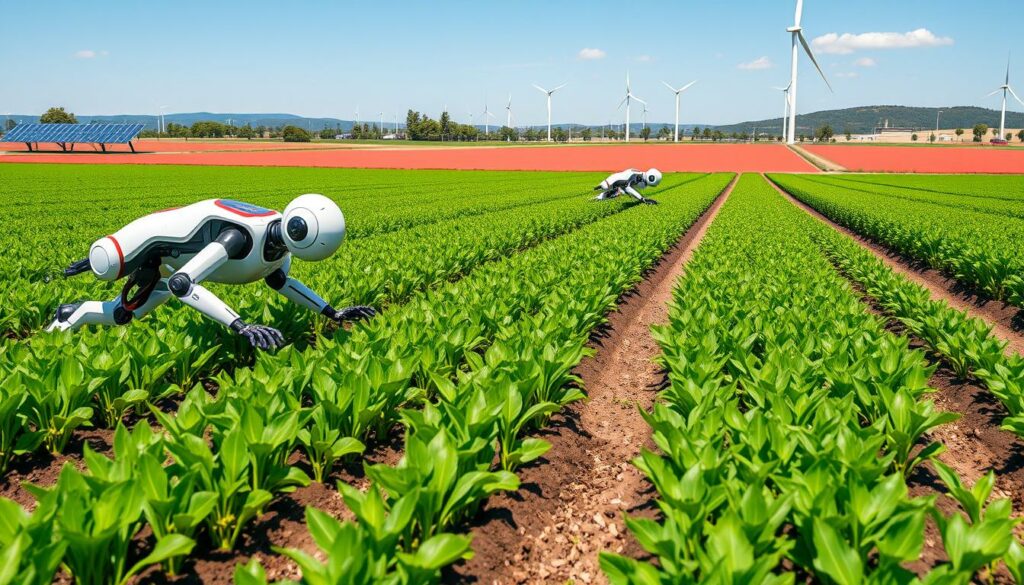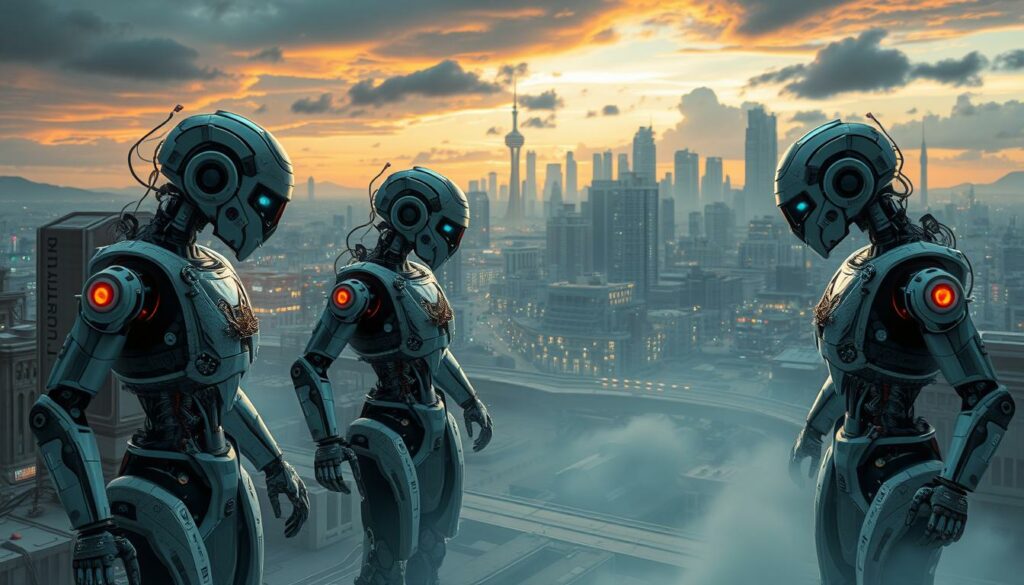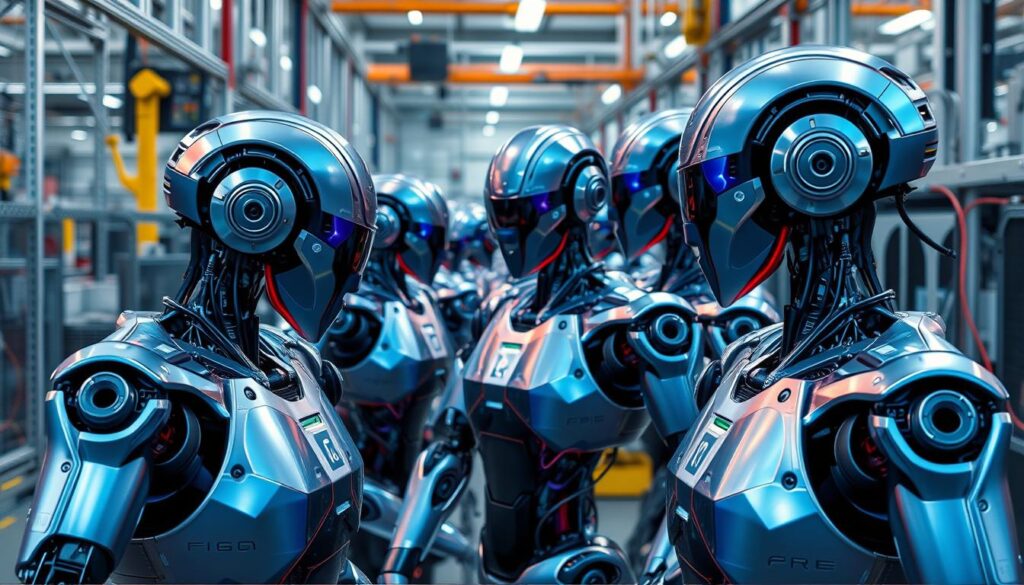The arrival of AI-powered robots marks a big leap in automation tech. These machines bring new skills that change how we work in many fields. By adding artificial intelligence to robotics, these machines do more than just help; they change the game. They make tasks like picking crops, doing surgery, and running industrial processes faster and more precise than ever before.
For instance, Inaho Inc., from Kanagawa, Japan, tested their AI-powered robot for picking cherry tomatoes in the Netherlands. This trial showed big steps forward in farming. The company aims to work with farmers to make this tech a big success, showing the huge promise of AI-powered robots in real life.
Looking into the world of robotics, we see how these new tools are key to solving big problems and building a better future.
Key Takeaways
- AI-powered robots are changing automation in many areas.
- Adding artificial intelligence makes robots work better and more accurately.
- Working together is crucial for making these robots a success.
- We need new robots because there aren’t enough workers in farming.
- New tech in robotics is changing old tasks.
Introduction to AI-Powered Robotics
AI-powered robotics combines technology to make machines smarter. It uses artificial intelligence and automation to learn from data and adapt. This mix changes how machines work, making tasks easier and more efficient.
Learning about robotics means understanding key terms like robotics, sensors, and machine learning. These terms show how technology helps make machines smart. Robotics has grown, leading to new uses like surgery, home automation, and industrial tools.
AI in robotics has brought big changes. For example, robots can now make quick decisions from lots of data. This is seen in healthcare, where robots do surgeries with great accuracy. They use special algorithms to recognize surgical gestures, showing how AI and robotics work together.
AI-powered robots help in many areas, from home chores to medical tasks. Companies like Northrop Grumman and KUKA AG are leading the way. They’re shaping the future of automation.
The Global Service Robotics Market is worth about USD 41 Million in 2023. It shows how AI is becoming part of our daily lives. Regions like North America, Europe, and Asia-Pacific are growing fast thanks to intelligent machines. Despite economic challenges, research and innovation in robotics keep moving forward.
Exploring AI’s role in robotics shows how it makes robots better and more useful. It changes automation in many areas. For more details, check out research articles and market reports, like what it means for the future of work.
Benefits of AI in Automation
AI in automation brings many benefits of AI that change how businesses work. It makes things more efficient, helping companies work better and less. AI does repetitive tasks, letting workers focus on big projects, which boosts productivity.
AI cuts down on human mistakes. It does tasks with accuracy, making fewer errors. This means better quality and consistency in making things and providing services. For example, companies using AI are getting faster and more efficient.
AI also saves money. It uses less people, which means lower labor costs. Companies can use their money better, on growing and innovating. The rise of remote work shows how automation makes things more efficient and flexible. You can learn more about this in this detailed article.
AI helps make better decisions by looking at lots of data. It finds trends and gives useful advice, helping businesses make smart choices. This can greatly improve how things are made and the services offered, making productivity better in all areas.
The benefits of AI in automation are clear. Using these technologies, companies can get a lot better at doing things efficiently, productively, and saving money. As AI gets better, it will play an even bigger part in automation, opening up new chances for innovation in many fields.
Emerging Technologies in Robotics
The world of robotics is changing fast, thanks to new emerging technologies. These changes are making robots work better in many areas. Advanced robotics are leading this change, especially with cobots. Cobots work with humans, making things more efficient and productive.
The service robotics market is growing fast, expected to hit USD 41 million in 2023. It’s growing at a rate of 15.3% each year. Companies like Northrop Grumman Corporation and iRobot Corporation are leading this growth. They’re making robots for both personal and work use, helping with everything from household chores to medical tasks.
It’s important to know how the market is divided. There are many types of personal service robots, used in education, entertainment, and nursing. This shows how automation is becoming more common in different areas, solving specific problems. For more details, check out the impact of big economic on this industry.
Robotic process automation (RPA) is key to making things run smoother. Companies use RPA to cut down on mistakes and work better. Also, robots are getting smarter, showing they can change how we do our jobs and improve our work.
Companies need to keep up with these new emerging technologies. As things keep getting better, understanding these changes will help them stay ahead. It’s key for finding new jobs and staying competitive.
| Type of Robotics | Application Areas | Key Benefits |
|---|---|---|
| Personal Service Robots | Household, Education, Entertainment | Increased convenience, cost efficiency |
| Professional Service Robots | Nursing, Rehabilitation, Medical | Enhanced care, reduced workload |
| Collaborative Robots (Cobots) | Manufacturing, Logistics | Improved collaboration, safety |
Role of Robotics in Agriculture
Robotics is changing farming by making it more precise and efficient. It uses advanced tech for tasks like planting, checking on crops, and harvesting. This change is key as farming faces issues like not having enough workers and needing more food for everyone.
Case Study: Inaho’s Cherry Tomato Harvesting Robot
Inaho’s cherry tomato robot started testing with Dutch farmers in May 2023. By July, it was picking twice as fast as before. This was thanks to new tech like a better chip, a sharp camera, and smarter AI.
The robot could tell tomatoes from other things and pick only the ripe ones. The Netherlands sends out about €65 billion ($72 billion U.S.) worth of food each year. Using tech like this is crucial for staying a top food exporter.

Impact on Labor Shortages in Farming
The farm industry has 2.4 million job openings, says the American Farm Bureau Federation. Robotics is a big help here. It automates tasks, helping farmers deal with the lack of workers, especially when it’s busy.
Using robots like Inaho’s fills the gap left by seasonal workers and boosts production. As farming tech gets better, it’s clear robots will be key in keeping up with food needs for more people.
Looking ahead, robotics in farming will bring more new ideas. For more on how AI is changing healthcare, check this out.
AI-Enhanced Robotics in Healthcare
AI in healthcare robotics is changing patient care and surgical precision. Surgical robots are getting more advanced, changing how surgeries are done. This makes healthcare safer and more efficient.
Advancements in Surgical Robotics
New tech in surgical robotics has improved how robots move during surgery. This means surgeons can do complex procedures safely and accurately. With AI, surgical robots are getting better at what they do.
The market for surgical robots is growing fast. It’s expected to reach USD 41 Million in 2023 and grow by 15.3% each year until 2030.
The Role of AI in Patient Safety
AI is key to making healthcare safer. It watches over patients in real-time and alerts doctors to potential problems. This helps prevent surgical mistakes.
By using smart systems, doctors can give patients better care. AI-enhanced robotics is vital in the medical field.
Looking into the future of healthcare shows how AI and surgical robots are changing things. Companies like Northrop Grumman Corporation, KUKA AG, and iRobot Corporation are leading the way. They’re making healthcare robotics better, setting the stage for big growth. For more info on trends and market insights, check out this resource.
Challenges in AI-Powered Automation
AI-powered automation brings many challenges for companies. One big issue is the high cost of starting up with robotics. Getting a new robotic system means spending a lot on hardware, software, and upkeep. This can be a big hurdle for many businesses.
Another big challenge is finding the right people to work with these robots. There’s a growing need for people who can run and manage complex robotics systems. This shortage of skills makes it hard for companies to automate.
There are also worries about AI taking jobs. Automation can make things more efficient and productive. But, it also makes people wonder about the future of work. The fear of losing jobs in certain fields makes companies think twice about using AI.
AI also brings risks like data privacy and bias in algorithms. These concerns make companies think hard about how to use AI. They need to focus on ethical use to gain trust in their AI solutions.
- High implementation costs
- Need for skilled personnel
- Potential job displacement
- Ethical concerns regarding autonomous decision-making
These challenges show how hard it is to add advanced robotics to current systems. It’s important to plan carefully and make smart decisions. Many companies look into the good and bad sides of automation. For example, this study talks about how generative AI affects different industries.

Future Trends in Robotics and AI
The future of robotics is all about fast growth in AI and automation. Companies are using technology innovations to change how robots work in businesses. Now, AI-powered robots help make many tasks more efficient.
Commercial Applications of Robotics
AI robots are becoming key in the business world. They help with things like keeping track of stock, serving customers, and moving goods. The demand for AI in robotics is growing fast. By 2030, the market size is expected to hit USD 41 Million, growing at 15.3% each year.
Big names like Northrop Grumman Corporation and iRobot Corporation are leading this change.
These robots are used in many areas:
- Household Robots
- Education/Entertainment Robots
- Nursing/Rehabilitation Robots
- Medical Robots
A recent study shows how commercial robotics is expanding. For more details, check out the study on the service robotics market’s trends and forecasts.
Sustainability and Robotics Innovations
Adding sustainability to robotics is now crucial. As the field grows, making robots use less energy is key to being eco-friendly. These changes help reduce harm to the environment and make robotics more sustainable.
Robots that use less energy can cut costs and help make manufacturing greener. This focus on sustainability matches the growth in robotics and AI, making the future of robotics smart and green. Learn how AI is changing industries at this insightful article.
Understanding the Intersection of AI and Robotics
The AI and robotics intersection is where these two fields work together to make things better. By adding AI to robotics, machines can learn and change to fit their surroundings. This makes them work better and more flexibly in places like factories, farms, and hospitals.
Looking into this area, you’ll see how AI helps make quick decisions. This change moves us from old automation to new, adaptable ways that can handle changes. Robots use machine learning to look at lots of data, making them better at complex tasks.
This tech has big benefits. For example, robots can do jobs once thought only for humans. They can put together complex parts in factories, manage farm data, and help with patient care. This shows how powerful the AI and robotics mix can be.
The future will keep getting better with new AI and robotics tech. Working together across fields will bring more new ideas. It’s important to invest in learning, like in cognitive science and AI, to get ready for the future. Looking into basic cognitive science can help you understand AI better.
This changing world is not just a new trend but a big change that challenges how we see automation. The mix of AI and robotics is key, pushing experts and researchers to see what they can do together.
Conclusion
The growth of AI robots is a big step forward in automation. These robots bring big benefits, like making farming more efficient and keeping patients safer in healthcare. But, we must also think about the ethical issues they bring up, like the need for rules on robot lies.
Looking into the effects of robot deception shows us the importance of this topic. It’s key to tackle the challenges of AI and robotics to use their full potential. We need to have good rules and ethical standards as we use these technologies more.
This way, robots and humans can work well together in a better future. The future of automation depends on our careful innovation and watching out for ethical issues. By acting wisely, we can use AI to make big improvements that help people and society.
FAQ
What are AI-powered robots?
AI-powered robots use artificial intelligence to work on their own. They learn from data and adapt to their surroundings. This makes them key in automation.
How is AI contributing to advancements in robotics?
AI makes robots smarter by letting them learn and get better over time. This means they work more efficiently, safely, and can do complex tasks. It’s vital in many industries.
What are some benefits of incorporating AI in automation processes?
AI in automation boosts efficiency and productivity. It saves costs, cuts down on mistakes, and speeds up decisions. This leads to better results in making things and providing services.
What are some emerging technologies in the field of robotics?
New tech includes collaborative robots, robotic process automation, and autonomous systems. These are changing how we do tasks in various industries.
How is robotics being applied in agriculture?
In farming, robots help with planting, checking on crops, and picking. They make farming more productive and efficient, especially when there aren’t enough workers.
Can you provide an example of robotic technology in agriculture?
A good example is Inaho’s cherry tomato robot. It’s shown to pick faster and more accurately in the Netherlands. This shows how AI can improve farming.
What role does AI play in healthcare robotics?
AI helps healthcare robots by making surgeries more precise and patient care better. Robots can recognize gestures finely, leading to safer and better surgeries.
What challenges does AI-powered automation face?
Challenges include being expensive to start, needing skilled people, possibly replacing jobs, and ethical worries about making decisions on its own. These show the hurdles in adding robots to current systems.
What future trends should we anticipate in robotics and AI?
We’ll see more AI robots in everyday jobs like managing stock and helping customers. There will also be a push for robots that use less energy and help the environment.
How do AI and robotics intersect?
AI and robotics come together to make machines that not only do tasks but also learn and adapt. This makes robots better at what they do, helping make things work more smoothly.
Source Links
1 . https://www.therobotreport.com/inaho-tomato-harvesting-robot-undergoes-trials-dutch-growers/
2 . https://www.mdpi.com/2076-3417/14/17/8021
3 . https://bitcoinist.com/adapting-to-market-trends-how-avenix-fzcos-pivlex-operates/
- My Guide to Understanding Data Centre Architecture: Core Components Every IT Pro Should Know
- Wazuh Home Network Setup: A Step-by-Step Guide
- Quantum Computers Decrypting Blockchain: The Risks and Implications
- Wazuh: Enterprise-Grade Security for Your Business
- Wazuh for Beginners: A Comprehensive Guide
Related posts:
 AI in Cybersecurity: The New Frontier in Protecting Data
AI in Cybersecurity: The New Frontier in Protecting Data
 Big Data Meets AI: Transforming Business Decision-Making
Big Data Meets AI: Transforming Business Decision-Making
 Natural Language Processing: How AI Understands and Responds to Us
Natural Language Processing: How AI Understands and Responds to Us
 How AI is Revolutionizing the E-commerce Industry
How AI is Revolutionizing the E-commerce Industry
 How to Use AI for Hyper-Personalized Customer Experiences
How to Use AI for Hyper-Personalized Customer Experiences
 I am Uncovering How AI is Fooling the World
I am Uncovering How AI is Fooling the World
